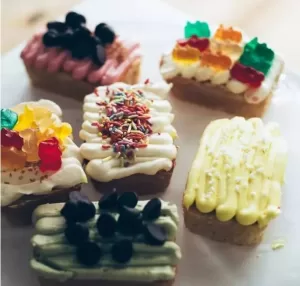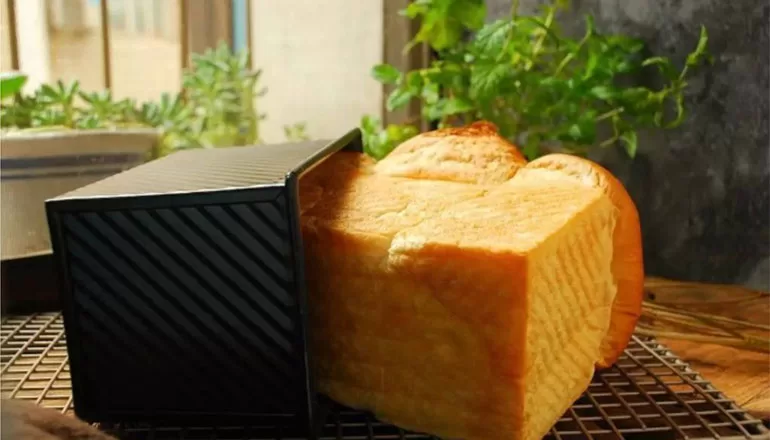Here are 54 baking tips and tricks for you to share!
I wish you all a smooth road in baking!

1. When did baking start on earth?
5.6 centuries B.C. Ancient Greece.
2. What was the reason for the separation of pastry chefs and bakers in the 17th century?
Pastry and bread making require different oven temperatures, and since modified ovens cannot be easily adjusted, bakers and pastry chefs found it more convenient to use separate ovens from now on.
3. What is the formula for the percentage of ingredients in bread making?
Total weight of ingredients/total weight of flour *100% = % of ingredients
4. What is the role of grease in baking?
It can shorten the length of the gluten and lubricate the gluten by covering the cake so that the gluten will not stick together.
5. How many steps are there in the baking process?
Whether it is bread, cake or biscuit, the baking process is divided into several steps. Whether it is bread, cake or cookies, the baking process follows this process
(1) Formation and expansion of gases (release of carbon dioxide, water vapor by yeast, soda),
(2) condensation of gases in bubbles (bubbles in gluten, gases in protein paste)
(3) starch gelatinization (starch absorbs water and begins to gelatinize when heated to about 60 degrees, giving the product its shape)
(4) Protein coagulation (protein starts to coagulate at 74 degrees)
(5) Evaporation of part of the water (so the baked bread will be light and the uncooked ash will be heavy)
(6) Melting of fats and oils (different fats and oils melt at different temperatures and release gases).
(7) Crust formation and coloring (evaporation and drying of water on the surface of the product to form the crust, and milk, cane sugar and eggs increase the coloring).

6. Why should bread not be refrigerated?
Aging begins as soon as the bread comes out of the oven, with the loss of moisture and chemical changes in the structure of the starch. This change occurs more rapidly in refrigeration and virtually stops in freezing.
7. Why is wholemeal flour with germ not easy to store?
Wheat germ is high in oils and fats and has a high nutritional content, but is very susceptible to rancidity.
8. Is bread flour the same as high gluten flour?
Bread flour contains about 12% protein, whereas high-gluten flour should contain more than 14%. 9.
9. How many types of sugar (sweeteners) can you name in baking?
(1) Adding sweetness and flavor
② soften the gluten structure. ② soften the gluten structure.
③Increase the surface color
③Increase surface color ④Retain moisture Extend shelf life
⑤ Mixed with fat, it can be used as emulsifier. ⑤ Mixed with fat, it can be used as emulsifier. ⑤ Mixed with egg, it can be used as foamer.
⑥ It is the target of yeast.
10. add 3% cornstarch when you grind granulated sugar into powdered sugar yourself.
11. in bread making, equal amounts of milk are not equal to equal amounts of water.
Fresh milk contains 88-91% water and the rest of the solids are proteins . The rest of the solids are proteins. lactose and minerals, so if you substitute milk for water in a recipe, add a little more as appropriate so that the dough is not too dry.

12. what are the three types of whipping cream?
Low fat whipping cream 30%-35%. High fat whipping cream 36%-40%. Heavy cream 48%.
13. The best storage temperature for eggs is 2°C. 14.
14. What are the grades of eggs according to their weight (in shell)?
Large 70g. extra large 64g. large 57g. medium 50g. small 43g. very small 35g.
15. What is the role of egg in baking?
①Produces structure: proteins coagulate during baking; eggs make food more chewy and tough. The addition of fat or sugar can make the finished product softer.
Promote the emulsification of fats and liquids: egg yolks contain natural emulsifiers that make the dough smoother. It helps to increase the volume and make the texture softer.
③Foaming: the process of whisking the egg, wrapped in a large amount of air, in the baking of the air in the heat expansion, help batter expansion.
④Fat use: The fat in the egg yolk can be used as grease. When the fat content in the product is low, the role of the fat in the egg is very important.
⑤ Moisture: Eggs contain a lot of water, and this water can be seen as part of the total water volume in the recipe.
⑥ Flavor: Egg aroma (also viewed as fishy egg)
⑦ Nutritional value
⑧ Color: Egg yolks give the dough and batter its yellow color. At the same time, the egg easily turns brown with heat, which in turn enhances the color of the product’s appearance.
16. What is fermentation?
Fermentation is the process by which yeast interacts with sugar to produce carbon dioxide and alcohol (the alcohol evaporates and the carbon dioxide expands, thus increasing the volume of the product).
17. What is the relationship between yeast activity and temperature?
Inactive at 1°C (storage temperature). 15-20℃ low activity. 20-32℃ high activity. 20-32℃-high activity. Above 38℃ – reaction slows down. Inactivated at 60℃.
18. What are the two types of baking powder? What are the characteristics?
①Single-acting baking powder: It produces gas immediately when it meets water, and it is only used for products that are baked immediately after mixing.
② double-effect baking powder: low temperature release of some gas, the reaction will be complete after heating, the batter can be left for a period of time after preparation.
19. Can gelatin powder and flakes be replaced with each other?
Yes, except for the different processing methods, their functions are exactly the same. 1 teaspoon of gelatin powder = 2.8g.
20. What is the water absorption capacity of gelatine?
Gelatin can absorb 5 times its own weight in water.

21. What is the purpose of cooling bread after baking?
After baking, the bread should be cooled on a wire rack immediately to release excess water. This is to release excess water, alcohol and residual carbon dioxide from the fermentation process.
22. How to keep the crust of soft bread soft and tender?
You can prevent the crust from becoming hard by brushing it with a layer of melted butter before it cools in the oven.
23. How should I store hard crust bread (French)?
It is best to store it at room temperature for 6 hours. Unless it is frozen, it should not be wrapped, otherwise it will soften the crust and the texture will be like a leathery version that is hard to eat!
24. How many ways are there to ferment dough? What are the characteristics?
① Direct method: short time and quick results, the flavor organization is not as good as the last two types
② Refrigerated fermentation: good flavor; but the time and temperature are not easy to control, easy to over-fermentation. Temperature is not easy to control, easy to over-fermentation
(iii) Medium-seeded method: refrigerated fermentation is used only for medium-seeded; the production time is flexible, the amount of yeast is saved, and the flavor organization is much better than the direct method, and it is resistant to storage and not easy to be aged.
25. what is the direct method of bread. What is the direct method? What is the difference?
The direct method, also known as the primary fermentation method, is the method of operation in which the bread production process undergoes the primary fermentation procedure. The medium-seed method, also known as the secondary fermentation method, is a method of production that involves a secondary fermentation stage. The fermentation phase of the bread process results in a better network organization of the dough and the production of the characteristic aroma of fermented bread. The second fermentation phase results in a longer fermentation period, which makes the dough more mature in terms of its effect and characteristics.
26. Is it possible to put the bread into the oven at 28℃ in winter because of the cold weather?
Yes, it should be placed in the oven at 28℃ with 75-85% humidity. They should not be placed in the oven because the oven does not have the appropriate humidity.
27. Why is salt and cream added at the end of the mixing process?
The reason is that adding salt and cream at the same time as the dry yeast will directly inhibit the growth of the yeast, and adding the salt at the end will shorten the mixing time and reduce energy loss.

28. Can oxidizing additives be used together with emulsifying additives?
No. An additive is a supplementary material that is added to the bread in response to a deficiency in one of the characteristics of the bread. Oxidizers and emulsifiers are used for different characteristics and should not be mixed.
29. What is the difference between high sugar yeast and low sugar yeast?
High-sugar yeast and low-sugar yeast are produced according to the ability of the yeast to adapt to the raw material. High-sugar yeast is used when the sugar content in the recipe is 10% or more; low-sugar yeast is used when the sugar content is less than 10% and is more effective.
30. What is the difference between a horizontal mixer and a vertical mixer?
Horizontal mixers have a slower mixing speed and different physical action, which makes it difficult to fully expand the gluten, so it is usually pressed by a pasta press to help bind the gluten. The mixing speed and mechanical structure of the vertical mixer can directly expand the gluten in the mixing process.
31. Is it possible to add ice when mixing in summer when the temperature is too hot?
Yes, you should mix the raw material at a slow speed until it is dissolved before switching to fast mixing.
32. Why is it necessary to add oxidizing additives for rapid production?
Since the quick method does not go through the normal fermentation stage, it is necessary to add oxidizing additives to help the gluten to oxidize and mature and to shorten the fermentation time.
33. Why does the surface of bread collapse after baking?
- A. Over-awakening
- B. Under-baking
- C. Dough aging during operation
- D. Failure to ventilate during operation
- E. The dough has not been ventilated properly during handling

34. Why does toast shrink after baking?
A. The gluten is too strong. B. The gluten is not sufficiently loosened during molding and the molding is too tight. C. Failure to remove the mold in time after baking will cause the waist to shrink.
35. Why is the bread not bright enough after baking with egg wash?
If the bread is swiped with egg wash before the surface dries up after rising, the surface will lack of luster after baking.
36. Why are there big bubbles under the crust after baking?
The high temperature during the rising process will cause the surface to become mushy, so that bubbles will be formed under the crust after baking.
37. How much sugar should be used in bread making?
The amount of sugar should be within the range of 0-25%.
38. What is the difference between fresh yeast and dry yeast?
Fresh yeast, also known as pressed fresh yeast, contains large amount of water and needs to be kept at low temperature for 3 months, and the dosage is 2-3 times of normal dry yeast; dry yeast is processed by dehydrating and drying, and it can be kept for about 2 years after being vacuum-packed.
39. Why is there water on the surface of the dough after mixing?
If too much water is added to the flour, the protein content of the flour is low and the gluten is insufficient; if the flour is used immediately after production without oxidizing period; and if the mixing is too much, the water retention of the dough will be lowered and water will appear on the surface of the dough.
40. What is the phenomenon of insufficient rise?
Insufficient rising volume after baking. Rough organization and burnt smell.
41. What is the reason for thick crust after baking?
Insufficient humidity during rising and lack of appropriate baking temperature and time, resulting in excessive evaporation of water. 42.
42. Why is the freshness period of packaged bread short?
After baking, the bread is not cooled down sufficiently, and the water will be easily attached to the package, which will make the bread easy to be infected by bacteria and become moldy.

43. What is the reason for the crepey surface of bread?
Insufficient loosening of the bread during molding, excessive moisture in the final rising stage, and too big a temperature difference between the cooling temperature and that of the bread after coming out of the oven will make the bread surface crepey.
44. What is the ideal temperature after mixing? How to control it?
Generally speaking, after mixing, the ideal temperature is 26-28 degrees Celsius. The temperature of water can be controlled.
45. Can I eat freshly baked bread?
The lactic acid and acetic acid in the bread tissue will not be completely evaporated until about 2 hours after baking, so it is recommended to leave the freshly baked bread to cool down for 2 hours. It is recommended to leave freshly baked bread to cool down for 2 hours, because the enzyme action is still going on in the high temperature of freshly baked bread, and a lot of carbon dioxide will be produced until the center temperature of the bread drops to about 40℃, then the enzyme action will stop and the carbon dioxide will be fully discharged.
46. How to tell if the cake is cooked?
(1)Look at the color and puffing situation
Generally speaking, the cake is ripe to a certain degree of puffing will fall back a little bit, this time the cake has been basically stereotypes; and then look at the color situation, the color is uniform that the cake may have been ripe.
(2)Poke holes to see if there is mucus
You can use a toothpick or bamboo skewer to poke into the cake inside, pull out to see if there is mucus, if the cake is ripe will not be stained with mucus, on the contrary, not ripe will have.
(3)Patting and listening to the echo
Rapidly pat the cake body with your hand, if it makes a “rustling” sound, it indicates that the cake is not fully cooked.
(4)Press gently to see the elasticity
Press the skin of the cake gently with your finger, see if the pressed part will pop up quickly, if yes, it means the cake is cooked through and has good elasticity, if it pops up slowly, it still needs to be baked for a while.
47. What should I do if the cake is not cooked?
Can be directly put back into the oven to bake, not cooked cake can be put back into the oven to continue baking, but at this time to pay attention to the oven temperature regulation and time control. Here can be divided into several situations:
(1) Freshly baked
If the cake is just out of the oven and found to be undercooked, you can immediately put it back in the oven to bake. Since the temperature of the cake does not change much, it is fine to continue baking at the original temperature.
(2) Remove from the oven for a period of time
After the cake has been out of the oven for a while, the temperature of the surface layer has dropped, but the temperature inside is still very high, so if the cake is baked at the original temperature and time, it may affect the organization of the cake. Therefore, it is recommended to lower the temperature or cover the cake with tinfoil and bake again.
(3) Completely cooled down
It’s a bit tricky. Cake completely cooled only to find that the inside is not baked, and then put back in the oven for baking is not quite right, then the oven needs to be fully heated cake. Baking. The heating of the oven is from the outside to the inside, so the heating of the inside will be slower than the outside, and the heating of the skin will be more serious.
So it is advisable to put it in the microwave for a few minutes or steam it in a pan.

48. Why does the dough not rise when making bread?
There are many factors affecting the fermentation of dough. The first thing to consider is whether the yeast has failed. There is a simple way to check if the yeast is still active. Prepare half a cup of warm water at 30℃, add 2 grams of sugar and stir until dissolved, then add 5 grams of yeast and stir to dissolve, let it rest for half an hour, if the active yeast is good it will produce bubbles, and the bubbles will gradually overflow out of the cup in half an hour’s time, if it rests for one hour and does not produce much bubbles, it means that the yeast is no longer effective. Therefore, it is recommended to buy yeast in small packages. In addition to this, if the dough is over-mixed, it will be too watery. Excessive moisture in the dough. Temperature during fermentation. The amount of salt and so on may affect the fermentation speed and effect of the dough.
49. Why the chiffon cake will shrink and collapse? Collapse?
The whipping of the egg white is the first element that affects the success of chiffon, whipping the egg white can be tested by inserting chopsticks into the whipped egg white, inverted the mixing bowl, and the chopsticks will not fall to check whether the egg white is whipped in place. When mixing, do not use a circular mixing method, and quickly mix from the bottom up to prevent the egg whites from foaming. Adjust the baking temperature according to the performance of your oven. Invert the cake after baking to prevent shrinkage. 50.
50. When baking cookies, they look baked, but the inside is not yet cooked, why is that?
Each oven is different, so the temperature will be different. You will need to test your own oven several times to determine the proper temperature. If the temperature of the upper and lower heating tubes of the oven can not be individually controlled, there are also some small ways to control the oven temperature. For example, you can block part of the fire by putting another baking tray underneath the baking tray to prevent the lower fire from being too hot, and you can also use tinfoil to cover it to prevent the upper temperature from being too high, which will cause the cookies to be prematurely colored on the surface even though they are not yet fully cooked.

51. How can I whip the animal cream in place?
Animal cream is natural and healthy, but the disadvantage is that it is not easy to whip and melts easily when whipped and exposed to heat. If the weather is hot and the temperature in the operating room is too high, it will affect the whipping of the cream. To ensure the success of whipping cream, the first thing to note is that the container for whipping cream should be free of oil and water. Clean and dry, the cream for whipping is recommended to be refrigerated for 24 hours in advance, or in the whipping, the first in a large basin filled with ice cubes, pads in the whipping cream under the basin, whipping until the cream volume significantly larger, appear clear lines, stop continue to beat, so as to avoid the cream appeared in the state of the oil and water separation of the dregs of the state, can not be used for laminating. 52.
52. How to check if the eggs are fresh?
To check whether the eggs are fresh or not. Put the egg in a bowl of water. If it sinks, the egg is fresh.
53. What happens if I don’t sift the flour for making dough?
Are you too lazy to sift, or don’t think sifting is necessary? Some professionals believe that it is important to sift flour before mixing it with other ingredients to make a dough or batter. Try to mix in as much air as possible when you sift at the beginning, because slowly you will get a light texture no matter when you bake.”
Also, if you’re adding cocoa powder or other dry ingredients like sugar, it’s recommended to sift all dry ingredients. This allows all the ingredients to mix better . . more evenly.
54. What is the best level of wetness and dryness for making puff pastry?
Pick up the puff dough with a wooden spoon or chopsticks, the batter is in the shape of an inverted triangle, the tip of the batter is about 4cm from the bottom, and it can keep its shape and not fall down, then it is OK~This is one of the keys to the success of the puffs.

Copyright: This article is from the Internet, public service sharing, baking world editing and typesetting, if there is any copyright objection, please leave us a message to deal with!

